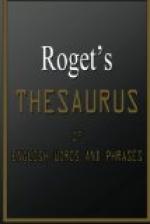In this file, comments
which are not a proper part of the thesaurus
itself are contained within arrow brackets thus:
<— comment —>.
Section headings, which
are not an actual part of the thesaurus
proper, are included between percent (%) markers.
Occasional references
to numbers starting with “@” are the embryonic
beginnings of a reorganized version, mentioned below.
A few comments are also included within curly brackets
{}.
Last edit 12-20-91.
============================================
The following additional differences will
be noted between this version
and the original edition of the printed 1911 thesaurus:
(1) the space-saving abbreviations in
the original, using hyphens to
represent common
words, prefixes or suffixes, have been expanded
into the full
words or phrases.
(2) the side-by-side format for words
and their opposites has been
abandoned.
Words are listed in order of their entry number.
(3) each main entry (1035 entries) has
a pound sign “#” in front of
the number to
facilitate computerized search.
(4) Greek words and phrases are transliterated
and included between
brackets in the
format gr/greek word/gr.
(5) where italics occurred in the original,
italics are used in the
Microsoft Word
format file. In the plain ASCII file, this
formatting is
lost.
(6) in the original book, words which
were obsolete (in 1911) were
marked with a
dagger. In this version, those words are marked
with a
vertical bar ("|").
Some of the words
which were still current in 1911, but are no longer
found in a current
college-size dictionary (presently obsolete words),
or which are no
longer used in the specific indicated sense, have been
marked with a
bar followed by an exclamation point “|!”.
However,
this marking process
has just commenced, and only a small portion of
the words which
are now obsolete have been thus marked. Most
though
not all of the
foreign-language phrases are now obsolete.
The “obsolete”
notation [obs3] indicates that the previous word (or
some word in the
previous phrase) is not recognized by the word
processor’s
spelling checker, and also is either not in a
modern
college-sized
dictionary, or is noted there as being “Archaic”.
(7) the approximate location of the bottom
of each page in the original
1911 printed book
is indicated by a comment of the form:
<—
p. 23 —>. To search for a page, note
that there are two spaces
between the “p.”
and the page number.
(8) This file contains only the main body
of the thesaurus. Neither
outline nor index
are contained here. The outline with an overview
of the organization
of the concepts is contained in a separate file,
“outline.doc”,
on the distribution disk.




